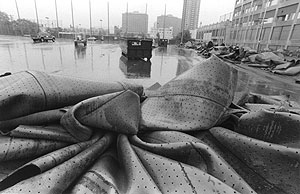 |
|
||
|
Vol. III No. 36 · Week of 23 June 2000 |
|||
B.U. Bridge is published by the Boston University Office of University Relations.
Change
at the grass-roots level
Malvern
Field goes au naturel
By David J. Craig
Some people won’t appreciate the renovations made to Malvern Field this summer, but they won’t be members of the BU women’s softball team. They will be the laundry workers who must remove grass stains from the team’s uniforms after home games and the groundskeepers who need to keep the grass mowed to trim perfection.
|
|
|
| This artificial turf was removed from Malvern Field in early June to make way for a natural grass softball field that will be ready in the fall. Photo by Kalman Zabarsky | |
Malvern is getting a new grass surface to replace the artificial turf field that has been in place at the corner of Malvern and Ashford streets since 1988. The new $400,000 softball facility will feature dugouts, an electronic scoreboard, and a new speaker system for game announcers. The facility is designed to attract more fans, allow BU to host NCAA softball tournaments, and make the softball program more attractive to high school recruits.
“I think everyone is excited about moving to natural grass,” says Bill Browning, assistant coach of the women’s softball team. “We’re consistently ranked in the top 5 or 10 teams in the Northeast region, and I think this will finally give our program the status that it deserves. Among 350 Division I schools, Fordham University is the only other team that plays on artificial turf.”
The old Malvern Field, which was torn up in early June, was made of a thin synthetic carpet similar to that of a putting green, atop a layer of foam padding about one inch deep. Beneath this was asphalt, with sandboxes forming the pitcher’s mound and the areas around home plate and each base. The surface was easy to maintain and durable, but unpopular with athletes and coaches.
“Artificial turf gives a ground ball a true hop because there are no imperfections in it,” says Browning, who had been pushing for a natural grass field for years, “whereas dirt or grass brings variety to the game. It was difficult for our players to visit teams that played on natural grass because those teams played that way all the time and got more used to playing odd hops.”
On the renovated Malvern, the entire infield will be dirt, and the outfield will consist of natural grass. The dimensions of the playing field will remain the same: about 200 feet to left and right fields, and 220 feet to center field. The field will also feature sprinklers that retract into the grass, drainage pipes to funnel rainwater from beneath the field into the city’s sewer system, and shrubbery behind a permanent 6-foot-high outfield wall. Previously, a portable, retractable home run fence had been set up for games. Dugouts will replace team benches, and seating for 500 spectators will be built along the first and third base lines. The facility will be handicap accessible, with space for wheelchairs behind home plate.
The construction is being done by contractors under the direction of the BU Physical Plant and should be completed in time for the softball team to host the first home game of the fall season on September 24. Currently, there are no plans for lights at the field, Browning says.
Robyn King (SMG’01), the Terriers pitcher who will captain the women’s softball team next year, looks forward to playing on the new surface. “The artificial turf makes the game a lot quicker, so some ground balls that would have been outs could become singles, and some singles could turn into doubles,” she says. “And I know, from playing other positions, that you’re reluctant to dive to make a catch because you just stick to that carpet. It’s not like sliding on grass.”
A study sanctioned by the National Football League in the 1980s found little difference between the severity and number of injuries on turf and grass. Still, professional athletes and trainers consistently complain that clingy artificial surfaces increase the likelihood of suffering noncontact injuries, such as tears to ligaments around the knees and ankles.
“We’ve been fortunate that none of our players ever suffered a severe knee or ankle injury that’s directly attributable to the artificial surface,” says Browning, “but there’s no question that the grass is going to feel better to the players. It’s a much softer surface. And I’ve gotten the feeling that some players we were recruiting were reluctant to come to BU because of our facility.”
Alan Weinberger, assistant athletic director and manager of athletic facilities, says that the Boston University Police Department has agreed to increase patrols in the area to discourage unauthorized people from using the field. “The security angle is a big one when you build a grass field because it can easily deteriorate,” he says. “That’s why some teams have one field for games and another field just for practice. But we’ve been locking the facility for the last couple of months to see what would happen, and we’ve been pleasantly surprised that we had few problems with people climbing the fence to get in.”
Weinberger says that it has not yet been decided if any other BU teams will have access to the field for practices. But recreational programs sponsored by the physical education department will have access to the field.
![]()
23
June 2000
Boston University
Office of University Relations
